Rome and Carthage: first clash
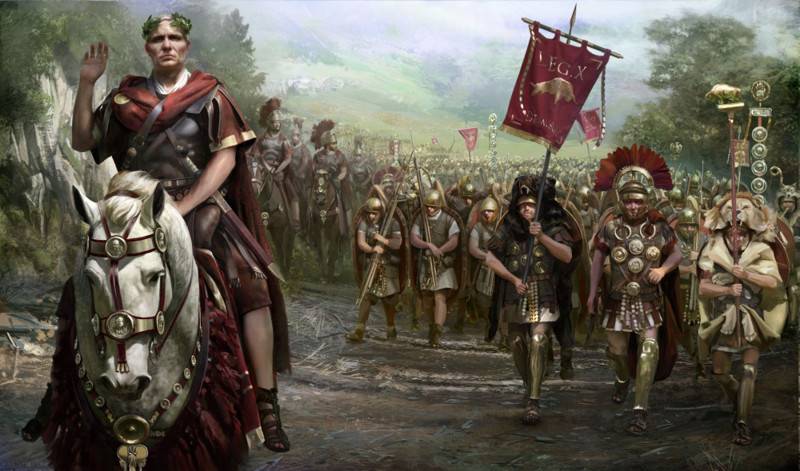
And Carthage, and Rome in the IV century BC. e. was lucky to stay away from the great campaigns of Alexander the Great. The conqueror's gaze fell to the East, where his victorious armies went. Early death of 32-year-old Alexander in June 323 BC e. led to the collapse of his state, the fragments of which were involved in the brutal wars of the Diadochs (successor commanders). And the diadochi also had little to do with Carthage and Rome: they divided and took away from each other the kingdoms and provinces that had already been conquered.
Echoes of a distant thunderstorm
The echoes of those events were still heard in the west.
The first of these was the fall of the ancient metropolis of the Phoenicians - the city of Tire, captured by Alexander after a seven-month siege in 332 BC. e. And this did not become a tragedy for Carthage, which was originally an absolutely independent Phoenician colony founded by fugitives from Tire. It happened back in 825-823 BC. BC, when, after the rebellion of the priest Melkat Akherb, his widow (and the king's sister) Elissa was forced to flee with the people loyal to her to the west. Here, on the North African coast of the Mediterranean Sea, the "New City" - Carthage was founded. After the death of Elissa, due to the absence of other members of the royal family, power in Carthage passed to the ten princeps.
At first, Carthage had almost no land of its own, engaging in intermediary trade and paying tribute to the surrounding tribes. In the XNUMXth century BC. e. a new group of colonists from Tire arrived in Carthage, which at that time was threatened by the powerful Assyria. From that time on, the gradual expansion of Carthage to neighboring lands begins: it subjugates previously free territories and the old Phoenician colonies. Gradually, the northern coast of Africa, including the lands beyond Gibraltar, the southwestern part of Spain, Corsica, a significant part of Sardinia and the Balearic Islands, the former Phoenician colonies in Sicily, the islands between Sicily and Africa, as well as the important cities of Utica and Hades. The fall of Tire under the blow of Alexander's troops not only did not worsen the position of Carthage, but, on the contrary, gave a new impetus to development and expansion, since, on the one hand, this state lost a powerful competitor, and on the other, it received a new wave of culturally and mentally close refugees from Levant, who brought with them considerable funds and replenished the population of Carthage and its colonies.
And the wars of the Diadochi threw out to the west only one "prominence", which turned out to be the second cousin of Alexander the Great on his mother - the Epirus king Pyrrhus. He was born 4 years after the death of the great Tsar Alexander, and, naturally, he did not enter the narrow circle of Diadochi, but managed to take part in their wars. We see seventeen-year-old Pyrrhus in the army of Demetrius Poliorketus and his father Antigonus One-Eyed.
In the decisive battle of Ipsus in Asia Minor (301 BC), the allies were defeated by the troops of Seleucus, Ptolemy, Lysimachus and Cassander, but Pyrrhus's detachment retained their positions. Voluntarily volunteering to become a hostage to Ptolemy, Pyrrhus was right: he managed to win the trust of this diadoch and even married his stepdaughter. With Ptolemy's help, he managed to regain the throne of Epirus. In the future, Pyrrhus tried to gain a foothold in Macedonia, but in the end, having received from another challenger (Ptolemy Keravnos) ransoms in the amount of five thousand foot soldiers, four thousand horsemen and fifty elephants, he went to "Great Greece", namely to Tarentum. So he managed to fight both against the Romans and against the Carthaginians, and his military campaign became a kind of prologue to the First Punic War. How? Now let's try to figure it out.
Prologue to the First Punic War
The fact is that in those days, between the possessions of Rome and Carthage, the rich policies of the so-called Magna Graecia were still located, but the Greek colonies here were already on the decline. Unable to defend themselves, they relied mainly on mercenaries for military affairs, the last of whom was Pyrrhus. The Tarentians invited him to war against Rome. Pyrrhus inflicted some very painful defeats on the proud queerites, but he did not have the resources to defeat Rome (this young predator, gaining strength). The most amazing thing is that, realizing this (and losing interest in further war), Pyrrhus did not go home, but transferred the hostilities to Sicily, where other Greeks, from Syracuse, promised the royal crown to one of his sons. The problem was that the Greeks controlled only the south of Sicily, the north-western part of the island had long belonged to Carthage, and in the northeast, dismissed Campanian mercenaries, calling themselves the "tribe of Mars" (Marmetins), were conveniently located in the northeast. These gallant guys, returning home, caught the eye of the city of Messana (modern Messina), which they captured, apparently deciding that it "lies badly". They liked this city and its surroundings so much that they didn't want to return home.
As usual, Pyrrhus started very well, pushing the Carthaginian army into the mountains and blocking the Mamertines in Messana. But, as we have already said, he clearly had little manpower and means for such a big policy, and the character of this commander did not tolerate routine work. And then the stubborn Romans again went to the south of Italy. As a result, unable to achieve complete and final success on any of these fronts, a disillusioned Pyrrhus went home to meet his fate - and soon died absurdly during the assault on Argos.
"What a battlefield we leave to the Romans and the Carthaginians!" He said, he said as he left Sicily.
Pyrrhus's words were prophetic. The war for Sicily between these states began ten years later, in 264 BC. e. AT history she entered under the name of the First Punic.
Carthage and Rome on the eve of the First Punic War
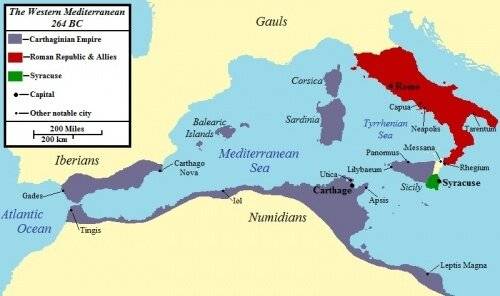
After the evacuation of Pyrrhus's army, the Romans easily subjugated the Greek city-states of southern Italy. And there, behind a narrow strait, is the large fertile island of Sicily, which the Carthaginians, the Greeks of Syracuse and the Campanian mercenaries not finished by Pyrrhus could not divide. And they all did not yet understand that the owner of the land, on which the favorable gaze of the Roman fell, there can be only one, and the happiness of all peoples is in submission to the great Rome.
Meanwhile, the arrogant Carthaginians already considered Sicily their "legitimate" prey, hoping sooner or later to take it under their control. But to the Romans who had established themselves in southern Italy, this island also did not seem superfluous. And the reason for the intervention was unexpectedly given by the ill-fated Marmetins, who, pressed by the Greeks, turned for help both to Rome and Carthage. Both those and others appeared. At the same time, Rome violated the terms of the peace treaty of 306 BC. e., according to which the Roman troops could not land in Sicily, and the Carthaginian - in Italy. But Roman lawyers said that the warships of Carthage during one of Pyrrhus's campaigns had already entered the harbor of the Italic Tarentum, so now the Roman legionnaires can also enter Sicily.
The first to come to Messana were the Carthaginians. However, then some strange story happened when, during negotiations with the arriving Romans, the Carthaginian commander Gannon was suddenly arrested. It is believed that the Romans captured him during a city meeting and tortured him into ordering the troops to leave the city. Later they let him go, but on the way to the Carthaginian possessions, Gannon was crucified by his own soldiers, who clearly considered him the culprit of their shame. And the Romans took the first step to capture the island, establishing themselves in Messana.
First Punic War
The alarmed Syracuse and Carthage, forgetting about the old enmity, entered into an anti-Roman alliance, which, however, did not last long. The successes of the Romans, to whose side the Greek cities of Sicily began to go over, forced the ruler of Syracuse, Hieron, to come to an agreement with Rome: prisoners were freed, an indemnity was paid, besides, Syracuse undertook an obligation to supply the legions with food.
In Syracuse, by the way, then the famous Archimedes lived and worked, and it was Hieron who instructed him to check his crown for the purity of the gold from which it was made, thereby contributing to the discovery of the law of hydrostatics. But the famous cars that caused so many problems for the Roman the fleet ("claws" of his name and "fire ray") Archimedes created another time - during the Second Punic War.
And we'll go back to the time of the First. After Syracuse went over to the side of Rome, the position of the Carthaginians became truly desperate, but they defended the city of Akragant for seven months, and the Romans took it with great difficulty.
So, during the first three years of the war, the Romans won victories on land, but they could not achieve complete victory largely due to the fact that their commanders changed every year, and the Greeks of the captured cities began to come to the conclusion that under the Punians they lived much better.
Then Carthage changed tactics, its numerous ships began to devastate the coast of Italy and destroy the oncoming merchant ships.

The Romans could not wage an equal fight at sea due to the lack of their own fleet of warships. The ships they had were mainly owned by the allies and were used only to transport troops. Moreover, Rome did not have the technology of military shipbuilding at that time. According to Polybius, a case helped the Romans to start the production of warships: one of the Carthaginian ships, run aground, was left by the crew. The Romans dragged this "gift" to the shore, and the construction of the navy began on its model. Moreover, the pace of its creation was simply amazing. Flor reports:
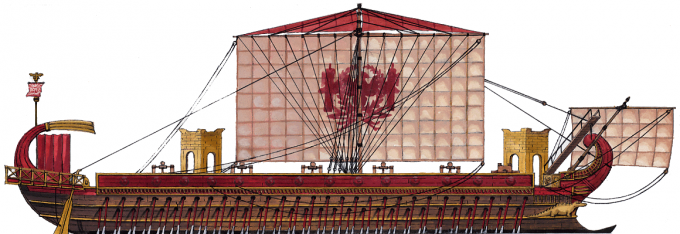
In parallel with the construction of ships on the shore, crews were being trained: future rowers sat at the oars on mock-ups of ships.
Carthage had another problem: there was no regular army in this state at that time: mercenaries were recruited instead.
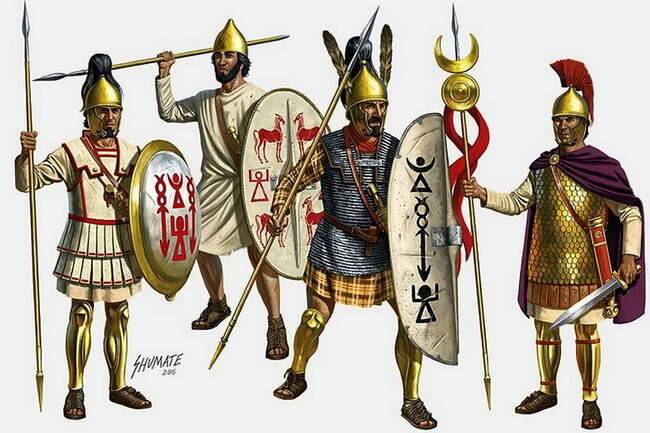
But the Romans, as we can see, solved their problem with the fleet, and very quickly. But Carthage never created a regular army, continuing to rely on mercenaries.
So, Rome had a fleet, it was time to put it into action, but the very first sea expedition of the Romans ended in embarrassment: 17 ships of the consul Gnaeus Cornelius Scipio, entering the Lipapa harbor, were blocked by 20 Carthaginian ships. The Romans did not dare to enter the sea battle, and the coastline was also in the hands of the enemy. The result was an inglorious surrender. But a few days later, a clash of two fleets on the high seas took place, and the Carthaginians suffered heavy losses. However, the real shock awaited the Carthaginian fleet in the battle at Cape Mila (the northern coast of Sicily). Here in 260 BC. e. 130 Carthaginian ships attacked Roman ships equipped with a previously unknown device - boarding bridges ("raven"), through which the legionnaires burst onto the decks of enemy ships.
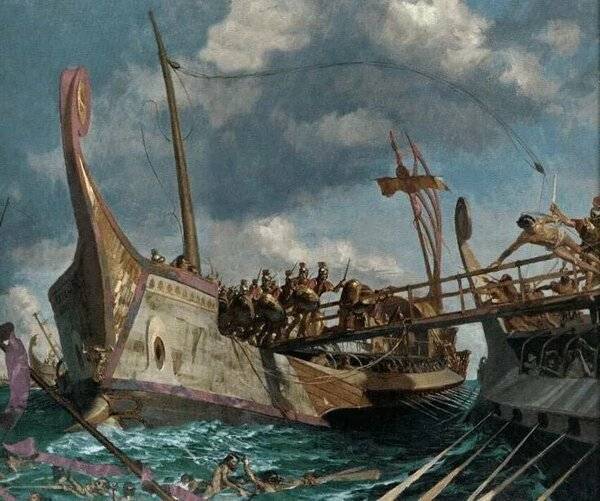
Thus, the Romans actually managed to turn a naval battle, where they felt insecure, into a land battle, in which they then had no equal. The Carthaginians were not ready for boarding battles and lost 50 ships, the rest fled. As a result, the consul Gaius Duilius was the first to be awarded a triumph for a naval battle. He also received another, very extravagant award: now, when returning from the feast, he was to be accompanied by a torch-bearer and a musician.
It should be said that the boarding "raven" significantly impaired the maneuverability of ships, this was especially noticeable during a storm. Therefore, with the improvement of the quality of rowing training, the Romans began to abandon their invention, preferring now to ram enemy ships.
The Carthaginian fleet suffered an even more terrible defeat in 256 BC. e. at Cape Eknom (southwest Sicily): 330 Roman ships attacked 350 Carthaginian ships, capturing 64 and sinking 30 of them. The losses of the Romans amounted to only 24 ships.
After that, the hostilities were transferred to Africa. Carthage was already ready for many concessions, but the consul Mark Atilius Regulus, who commanded the Roman troops, put forward completely unacceptable demands. In the end, he was defeated by the Carthaginians who mobilized all their forces, who, moreover, suddenly found a good commander among the new party of mercenaries - the Spartan Xanthippus. In the Battle of Tunet, the Romans were defeated, and Regulus was even captured along with 500 legionnaires. Before the Second Punic War, this defeat was one of the most severe in the history of Rome.
However, in the summer of 255, the Romans won another victory at sea, capturing 114 enemy ships in battle and evacuating the remnants of Regulus' legions from Africa. But then black times came for the Roman fleet. Initially, off the southern coast of Sicily, a storm sank 270 out of 350 ships. Three months later, the surviving ships, along with 220 new ones, fell into a new storm, losing 150 ships. Then the Romans were defeated in a naval battle near the Sicilian city of Drepan, and another storm destroyed the remnants of their fleet. All the fruits of previous victories were lost. In 247 BC. e. the troops of Carthage in Sicily finally got an intelligent commander, who became Hamilcar Barca, the father of the famous Hannibal. By that time, in Sicily, Carthage had only two cities under his control (Lilybey and Drepan), blocked by Roman troops. But Hamilcar transferred part of the army to Mount Herktu near the city of Panorma on the northern coast of Sicily. From the camp set up here, he constantly disturbed the territories subject to Rome.
So he fought for five years, and in 244 BC. e. he even managed to capture the city of Eriks, and the Carthaginian fleet dominated the sea at this time. There was no money for the construction of new ships in the Roman treasury, but the citizens of the republic built 200 new five-deck ships at their own expense. In March 241 BC. e. this fleet at the Aegadian Islands defeated the Carthaginian squadron, sinking 50 and capturing 70 enemy ships.
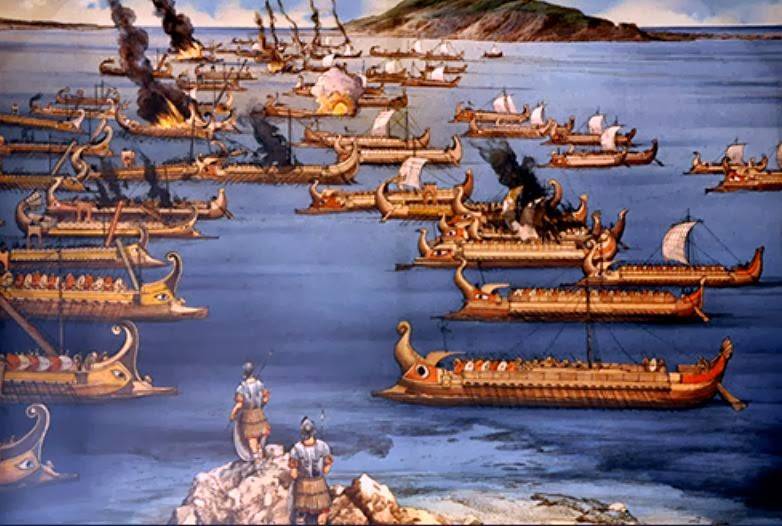
The situation turned upside down, and the now lost Carthage fleet was forced to enter into negotiations, the outcome of which was the conclusion of peace with Rome, the price of which was the concession of Sicily and the surrounding islands and the payment of a huge indemnity (3200 talents).
In addition, Carthage agreed to free the Roman prisoners free of charge, but had to ransom his own. In addition, the Carthaginians had to pay for the right to evacuate the army from Sicily. And Hamilcar Barka was forced to sign this treaty, whom Mommsen later called "the undefeated commander of a defeated nation." Carthage practically had no opportunity to fight, Hamilcar could do nothing, except raise his sons in a spirit of hatred of Rome and convey to them his revanchist sentiments.
This is how the First Punic War ended, the results of which did not suit either side and which became only the threshold of new bloody battles, the first step in the great struggle between Rome and Carthage for dominion in the Mediterranean.
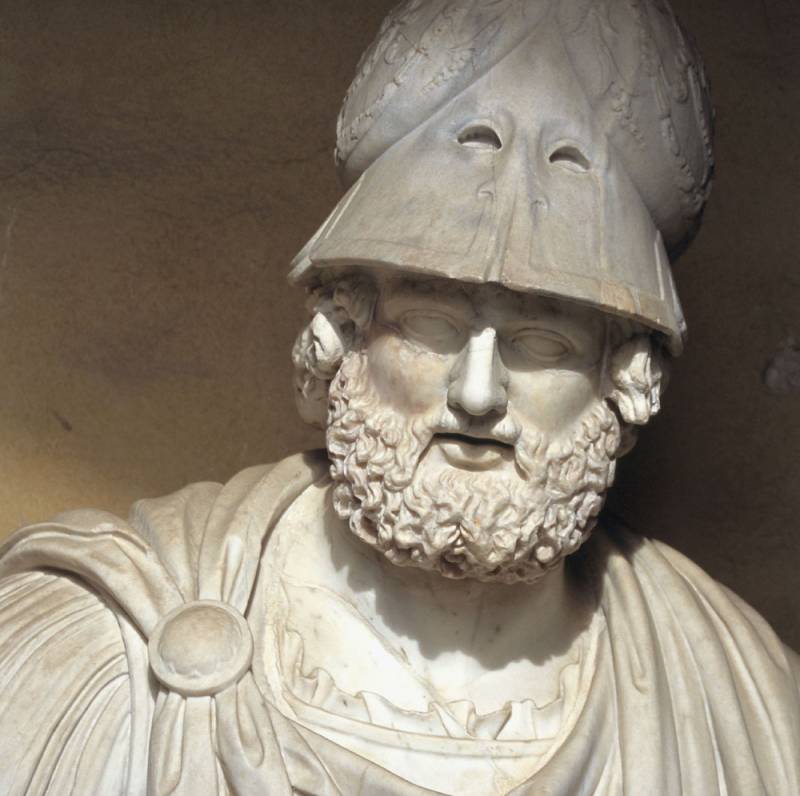
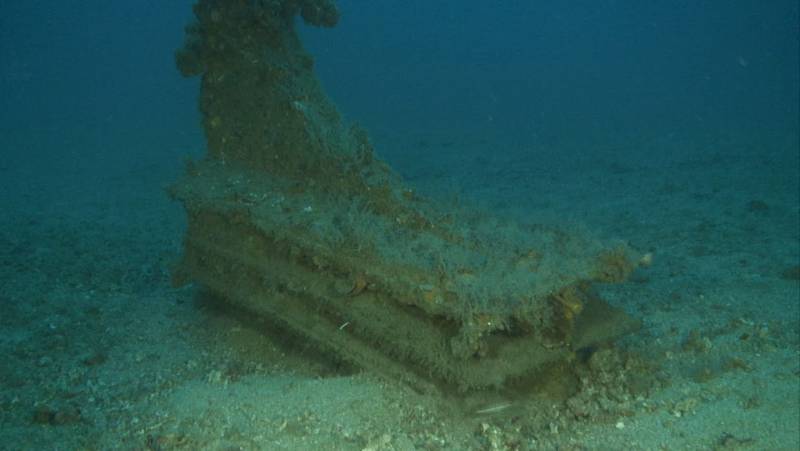
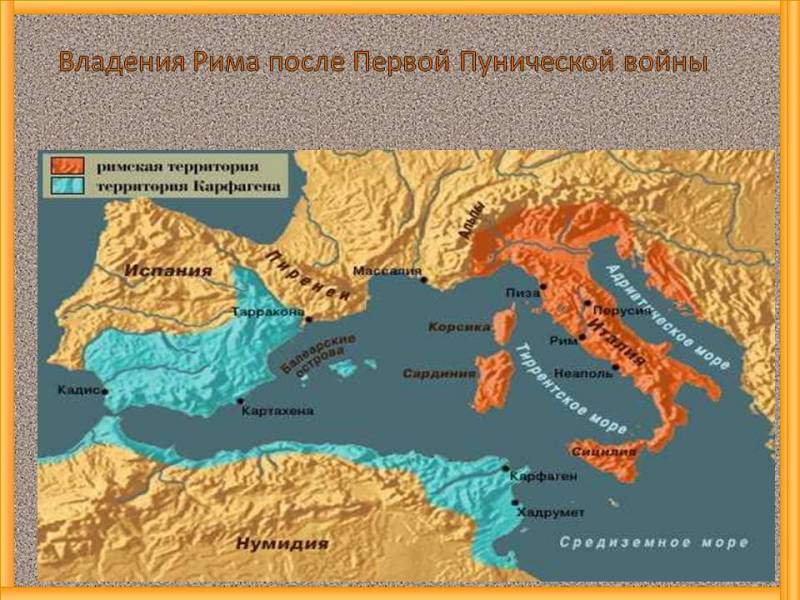
Information